Cowslip botanical illustration: Sketchbook study
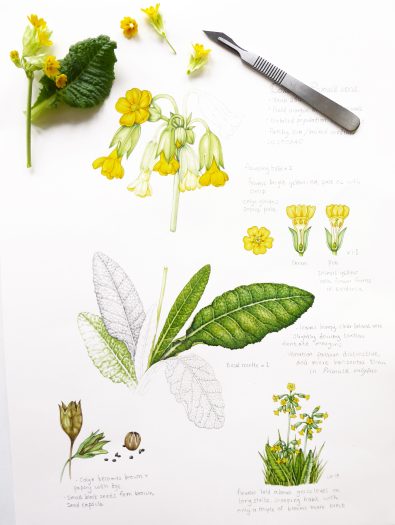
Late this spring, I completed a private commission to illustrate the Cowslip, Primula veris, as if doing a sketchbook study.

Sketckbook study sheet of the Cowslip
These are almost my favourite sort of commission as I can spend time really getting to know the plant, examing it from different angles, dissecting out its structures, checking out its growth habit, and exploring the intricacies of leaf venation and petal colour.
I’ve completed illustrations of cowslips for clients before, but not in this forensic sketchbook detail.
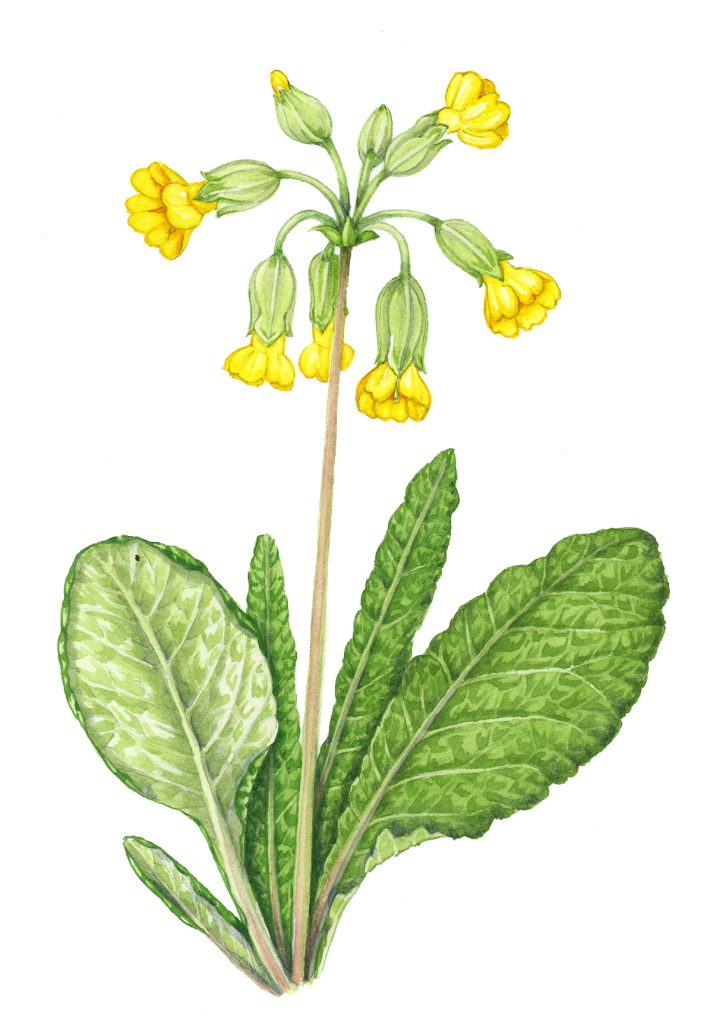
Cowslip illustration completed for the Wildlife Trusts
Waiting for the Cowslips to bloom
Sketchbooks studies really need a specimen to work from, so I had to wait for a patch of cowslips to come into flower.
This year they were late, I think they were held back by the late March snowfall. it wasn’t until May that my cowslips, on a roadside verge near a windswept meadow, came into bloom. They’re the same place every year; with botanical illustration you end up having a mental map of sites where different wildflowers bloom. These flowers are between the heights of Hay bluff and the farming village of Craswall.
I also have cowslips growing in the garden (my garden is full of “weeds”, mostly seeds from different things I’ve painted over the years, or plants I’ve planted out once I’ve illustrated them), but somehow I wanted to base this study on this little clutch of nodding flower heads by the edge of the field.
Cowslips, Oxlip, and Primrose: What’s the difference?
Cowslips are related to the primrose and oxlip; this becomes apparent not only when you look at the yellow flowers, but especially when you compare the crinkled, textured surface of the cloudy pale green leaves.

Primrose Primula vulgaris
Oxlip and cowslip flower at the same time, and telling them apart can be tricky. First, look at the colour of the flowers. Oxlip are a paler, colder yellow with a tinge of green. Cowslip flowers are a richer gold colour. The oxlip flower looks a whole lot like a bunch of tiny primroses on top of a flowering stalk, cowslips don’t. Cowlsip leaves often curve over downwards at the edges, so appear more rounded than oxlip leaves. Oxlip calyx have darker green nid-ribs; the cowslip calyx is uniformly pale green in colour. Some say (such as the rather wonderful UKSafari.com) that cowslips smell of apricots whereas oxlip don’t; it’s not something I’ve checked but it sounds plausible. Confusingly, you also have to bear in mind the False oxlip which is a hybrid of the cowslip and the primrose, and by no means uncommon.

Oxlip Prinula elatius (not an ideal illustration; it fails to make clear some of the most vital features)
Cowslip flowers
Cowslips grow from a basal rosette of crinkled oval leaves, and used to be common across meadowland. Now, with changes to farming practices, you’re more likely to find them on roadside verges, woodland edges, or in nature reserves. The flowers are held on top of a tall stem or scape, in a cluster of downward-pointing individual flowers. The tube-like structure of the individual flower is clearly seen, and looks almost loose within the calyx. They’re a bright clean yellow, with orange markings in the throat of the flower.

Close up of the cowslip flowers.
Heterostyly
As with the primrose, the cowslip has Heterostyly; two different flower-part arrangements within the same species. These are known as thrum and pin. Pin flowers hold their stigma above the stamens, thrum flowers have the stigma below the anthers of the stamens. This helps ensure that pollinator insects will gather pollen from one flower type and successfully pollinate the other type. This leads to cross breeding and genetic diversity. (For more on Cowslip heterostyly, click the link, or refer to the BBC Earth explanation of pin/thrum flower pollination.)
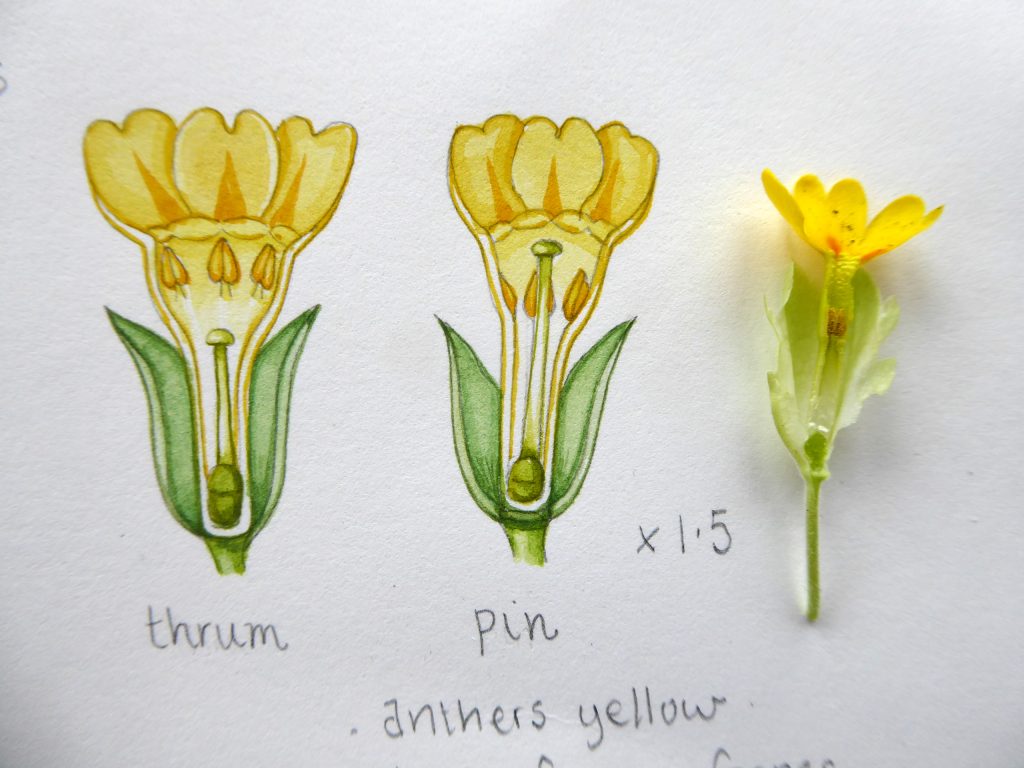
Pin and thrum forms of the Cowslip flower.
Interestingly, it was Charles Darwin who first noticed heterostyly in the Primula family. He postulated an explanation for it way back in 1862. His ideas are described in ablog by Plant Scientist.
Folklore of the Cowslip
There’s a great deal of folklore surrounding the cowslip. Its name is originally derived from the word “cow-slop” or cow pat. This refers to its love of pasture habitats. It can be used as a weather vane (a shorter stalk meant a drier summer). Fairies were meant to hide in the flowers. A ball of cowslips, known as a “titsy-totsy” was used by children in divination games. (“Titsy-totsy tell me true, who shall I be married to?”) The information on cowslip folklore and herbal remedies is taken from Christina Hart-Davies’s A Wild Plant Year, a book which is as fascinating as it is beautiful. It’s well worth investing in.
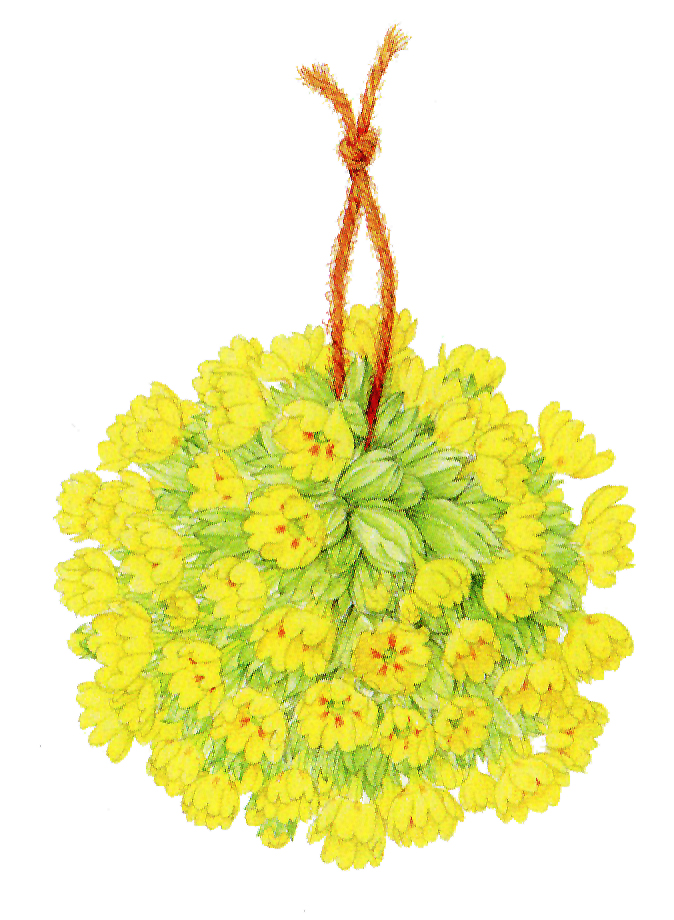
Christina Hart-Davies’s “titsy totsy” (the reproduction, scanned from the book, doesnt do the illustration justice)
The cowslip was used to make wine, to treat insomnia, sunburn, and headaches. It was also associated with Saint Peter as the Victorians believed the flowers to look like a bunch of keys.
Going about my Sketchbook study
When it came to illustrating my cowslip, I used Fluid 100 hotpress paper, Winsor and Newton watercolours, and my trusty Series 7 Winsor and Newton brush(number 1).
I started with a habit sketch, showing the plant growing in context; then chose one plant and did a big drawing of it cut to white.
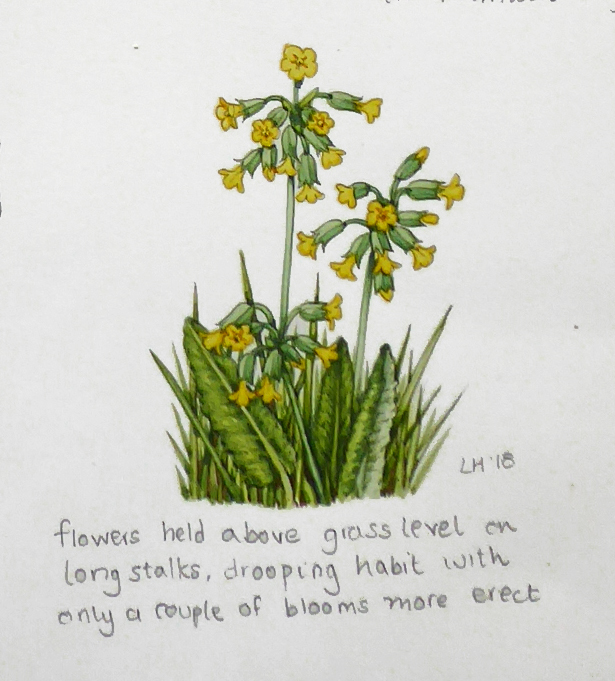
Habit sketch of the cowslip.
I worked into the leaves first. One leaf was a detailed line drawing showing the network of veins. The next was a tonal study, the third was partially painted, whilst the fourth leaf was painted in detail. Although these leaves are really tricky to paint, I’m obsessed by them and rather love getting lost in their crinkles.
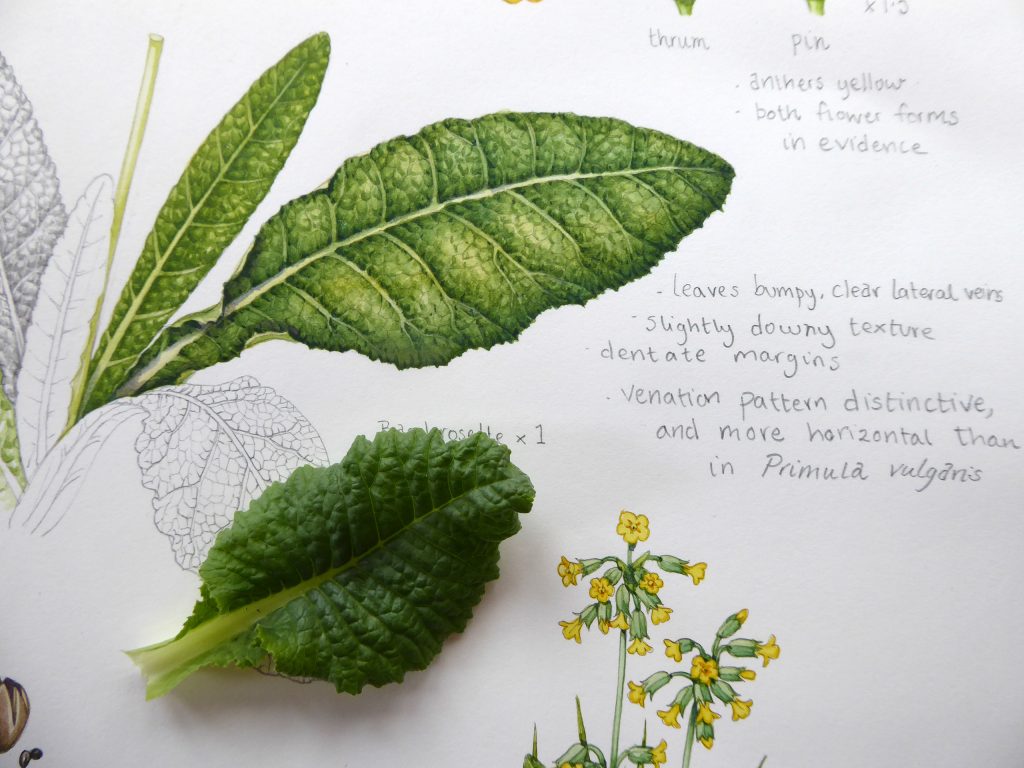
Painted cowslip leaf alongside a leaf from the basal rosette.
Sketchbook study of the cowslip flowers
Flowers next, mixing up that bright clean yellow with cadmium yellow pale and a touch of gamboge. I think Cadmium lemon would have been a better option, had I had it in the paitnbox.
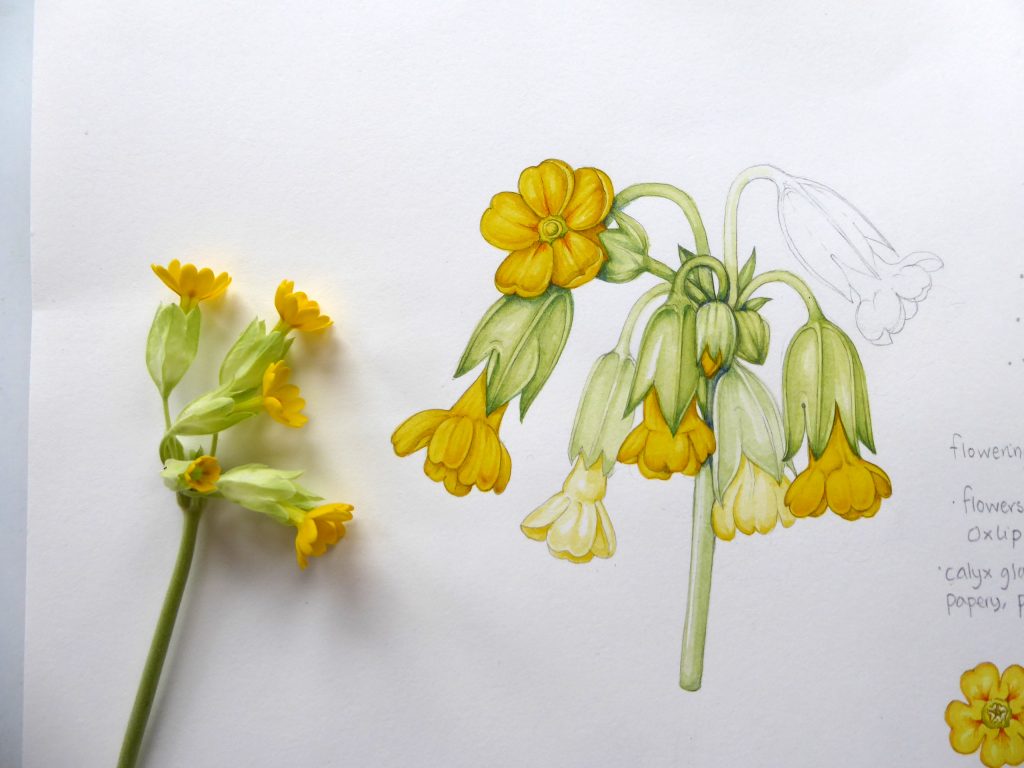
Cowslip flowers
It does have to be said though, that no matter how hard you try it’s almost impossible to really echo the glow of the natural colours of flower petals, and the cowslip is no exception.
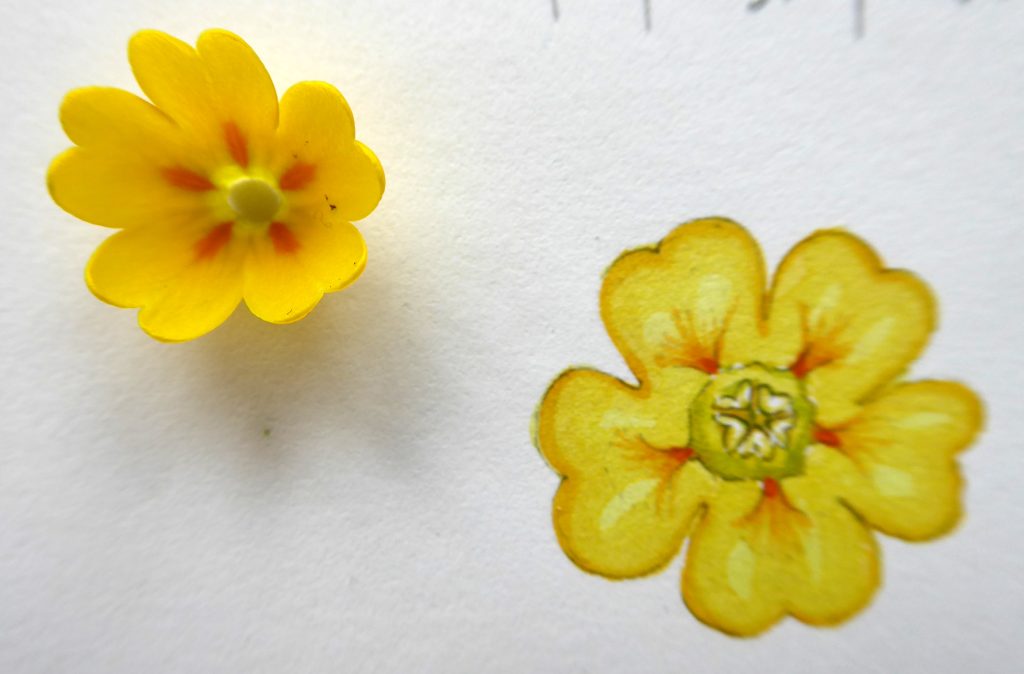
Individual flower, face on, showing the distinctive orange marks at the corolla base
Dissection of the flowers
Once the flowering head is illustrated, it’s time to get out a super-sharp scalpel and dissect it, then draw the results (hence the diversion earlier on pin and thrum heterostyly).
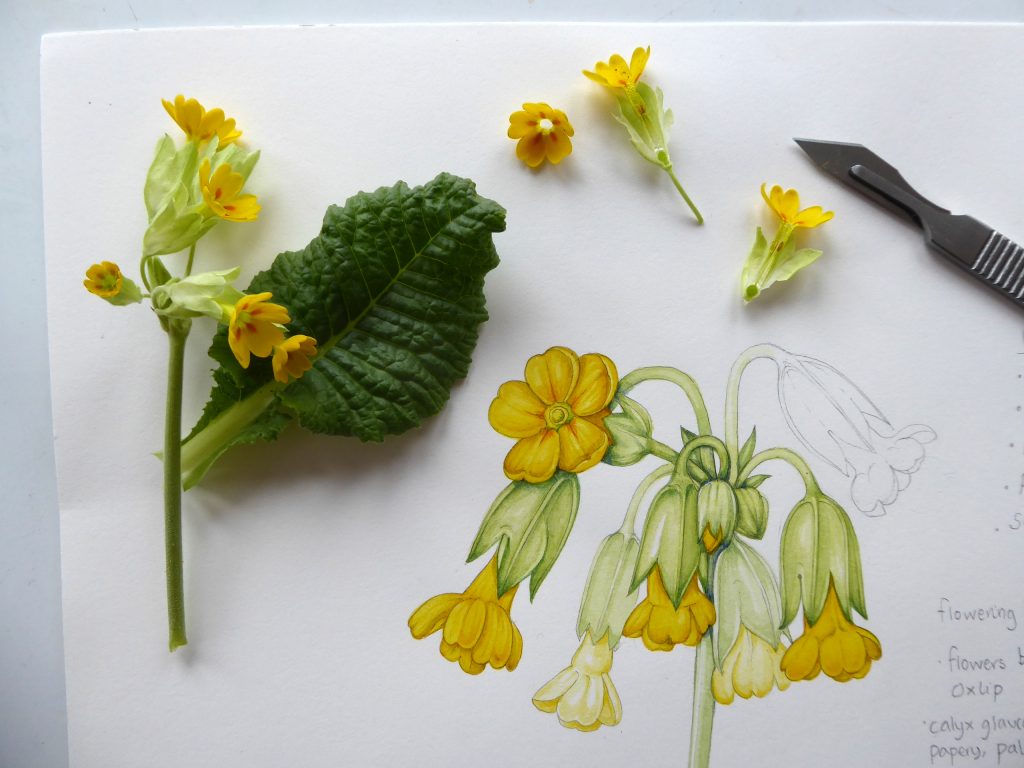
Cowslip flower dissection.
I save the seed heads from the cowslips that grow in the garden, so very luckily I had a few hanging around in the garden shed. This meant I could include information on the seed structure, and the persistent papery calyx remnants that surround them.
After these investigations and drawings; which are always accompanied with written notes on what the flower looks like, how it grows, what the colours are etc.; the sketchbook illustration is complete.
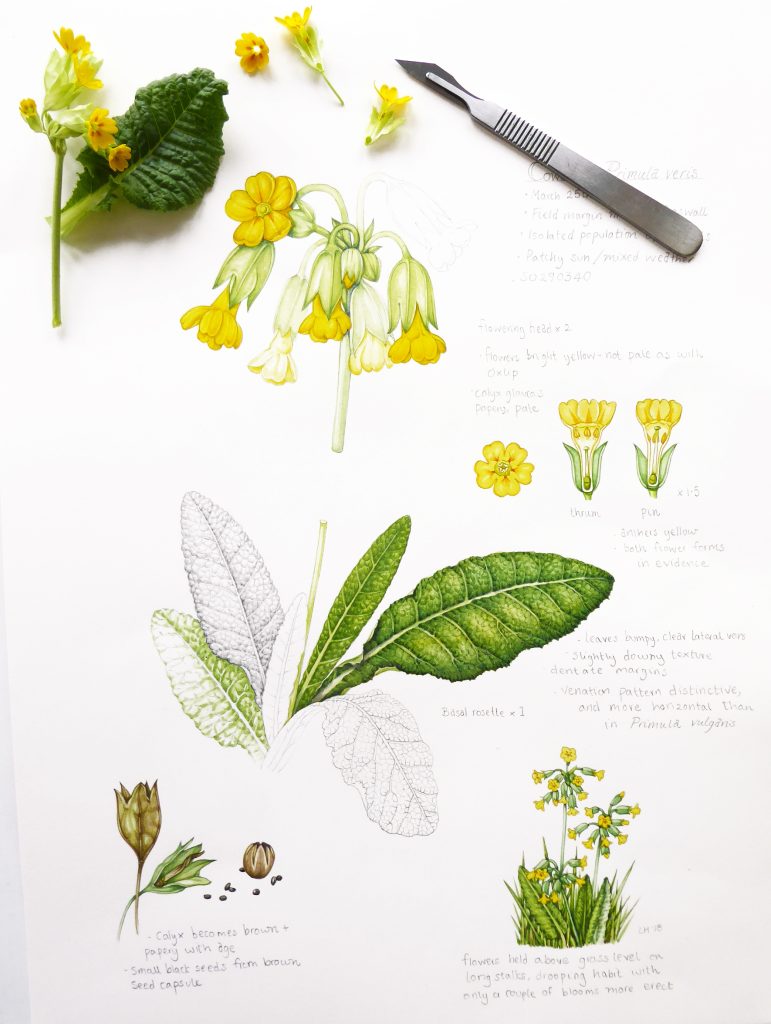
Finished sketchbook style illustration with scalpel and specimen
I sent it off to the customer who seemed really pleased with it, which is always a lovely feeling.
To be honest though, I enjoyed every moment of working on, and learning more about the gorgeous cowslip wild flower.

High resolution scan of the finished study of the Cowslip.


Thank you so much fir sharing. I really enjoy reading the article. Though I have never seen cowslips in place where I live. But it’s delightful to learn about this little plant.
Hi Chiny,
Theyre not as common here as they used to be, sadly, but I have some grwoing in the garden, in flower right now. It’s lovely to think of people all over the world thinking flowers from other countries are interesting. I remember living in Washington DC and being totally amazed by Dogwood trees cause we only had them in botanic gadens in the UK. Thanks for your comment. x
Thank you! You also did a nice dissection there of Cowslip. Have you ever dissected an Ozmanthus flower? I tried but it was so small!
Hi Sandra. Thanks! Nope, never dissected an Ozmanthus. Dissecting tiny flowers is sooo fiddly, I go through all sorts of contortions truing to cut cow parsley flowers in half! I feel your pain. x
Hello Lizzie
I am the Newsletter Editor for the Surrey Botanical Society. The county flower for Surrey is the Cowslip and I would like to use your drawing of it as a small image in the headline banner. If I did I would acknowledge you in the front page details and cite your website. Is that acceptable to you?
Best wishes
George
Hi George
Yes, that would be fine, Im flattered! If you email me on info@lizzieharper.co.uk then I’ll send a decent resolution version over, or feel free to use a screen grab is that’s large enough?
Many thanks
Lizzie